Projection mapping is the precise art of bringing everyday surfaces to life through vibrant animated light.
Crude projection mapping was used as early as the 1960s on theme park rides, but renewed interest in the technique for arts and advertising has encouraged an explosive growth in technology. Iconic structures like the Sydney Opera House and our own Music Hall in Cincinnati have been mapped and illuminated using powerful projection systems.
To create the magic, the “canvas” is captured in detail, and a framework is created for the size and placement of animations. From there, designers activate the surface with programs like MadMapper, Illumin, and Avolites.
Now that dozens of spectacular international-level events have featured projection mapping on static surfaces, creative teams are looking to push even more boundaries. Moving projectors that can track objects have the potential to make the medium fully mobile. Brighter projectors could enable daytime displays for 24/7 placemaking effects in retail environments.
THE NEXT SHOW: WHEREVER YOU WANT?
Further advances in projection will increase its accessibility. In-home or portable projectors are freeing us from the physicality of the screen. Some are even being created to fit into standard light bulb sockets.
STAYING POWER
Thanks to its flexibility, projection mapping is unlike any other form of digital media. Designers are free to create unique visuals across the entire natural and built world. Each new deployment has the ability to surprise and excite. As such, it has tremendous staying power. And it’s just one tool that the kolar | ralok team is experimenting with that helps us construct integrated experiences for our clients.
Kolar will be joining the creative community of Cincinnati at Blink, a four-day light and art festival scheduled for Oct. 12-15, 2017: featuring large-scale projection mapping throughout the city.

